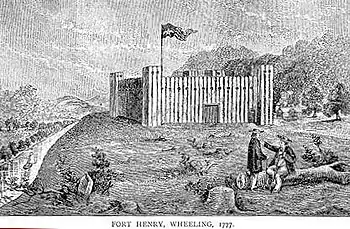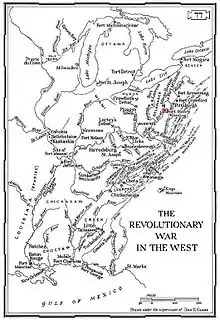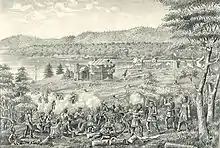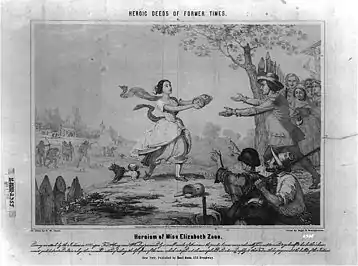Siege of Fort Henry (1782)
The Siege of Fort Henry took place from September 11 to 13, 1782, during the American Revolutionary War. A force of about 300 Wyandot, Shawnee, Seneca and Delaware Indians laid siege to Fort Henry, an American outpost at what is now Wheeling, West Virginia, accompanied by a force of 50 British officers and Loyalists from Butler's Rangers. The siege is commonly known as, "The Last Battle of the Revolutionary War," despite subsequent skirmishes between Patriots and Loyalists involving the loss of life taking place in New Jersey later in 1782; though these were more unorganized outbreaks of fighting between patrons with opposing sentiment than engagements between belligerents.
| Second Siege of Fort Henry | |||||||
|---|---|---|---|---|---|---|---|
| Part of the American Revolutionary War | |||||||
 Sketch of Ft Henry | |||||||
| |||||||
| Belligerents | |||||||
|
Wyandot Shawnee Seneca and Delaware Indians | ||||||
| Commanders and leaders | |||||||
|
Colonel David Shepard Colonel Silas Zane |
Captain Pratt Simon Girty | ||||||
| Strength | |||||||
| Just over 40 Virginia militia |
50 British officers and Loyalists ("Butler's Rangers") 260 Native Americans | ||||||
| Casualties and losses | |||||||
| 1 wounded[1] | Unknown | ||||||

Location
Fort Henry rests just off of the Ohio River in what is now Wheeling, West Virginia, between the southeast border of Ohio and northwest border of West Virginia. The colonists were disobeying royal order that all land west of the Appalachian Mountains was reserved for Native Americans, and the area had a history of violence between the natives and settlers.
Siege
The large force of Native Americans gathered on the Sandusky River under the direction of Simon Girty. Girty had been captured by natives as a child and grew up in their society, gaining notoriety for his savagery towards settlers. This force met with the Butler's Rangers and the entire company was put under the direction of Captain Pratt. The Rangers, a Loyalist Provincial unit from New York, had participated with Native Indians in the massacre of Patriot prisoners, women and children early on in the war during the 1778 Wyoming and Cherry Valley massacre.
As the force arrived at Fort Henry the Zane family, under direction of Colonel David Shephard, was charged with defending the fort. The defending force was made up of 40 men and boys protecting the 60 women and children from the surrounding area who had come to the fort for protection.
Girty and Pratt demanded surrender but Shephard refused, resolving to fight to the death in order to protect the people within his fort. The settlers were prepared to handle this siege because a similar force of Native Americans and British had attacked the fort before and burned all of the homes and buildings to the ground. Between the former siege and this one, the wooden model cannon that previously rested on the barracks had been replaced by a real one. In addition the homes of the settlers had been rebuilt, including that of Ebenezer Zane. His home contained a store of surplus ammunition and arms and it had been decided to occupy it in case of another attack. Being notified of the approach of the enemy by John Lynn, a scout, preparations were speedily made for the expected attack. Those who remained within the Zane house were Andrew Scott, George Green, Elizabeth Zane (Colonel Zane's wife), Molly Scott, Miss McCulloch, a sister of Major Samuel McCulloch, a slave and his wife, "Daddy Sam" and Kate. From all other homes the occupants had entered the fort. Although Colonel David Shepherd was the superior officer in the county, it appears that Colonel Silas Zane was again in command.

The first siege attempts were entirely aimed at destruction of the fort and surrounding area. The entire first day was wasted in attempting to batter the fort, and burn down buildings. On the first night natives attempted to burn down Colonel Zane's cabin but Daddy Sam saw the native and killed him just before the house was set on fire. The cannon was used heavily in defense of this first attempt, being fired 16 times with such effectiveness that the natives and British attempted to replicate the cannon out of a hollowed out tree wrapped in chains. When they attempted firing their makeshift cannon it exploded, killing and injuring the natives standing around. As the men defended against attacks the first day, the women in the fort had been pouring lead into bullet molds and dipping them into water.
The second siege on the following day was when the settlers ran into trouble. Their supply of gunpowder was running low and they would not be able to defend the fort much longer if they lost use of the cannon and their rifles. Elizabeth "Betty" Zane remembered the store of powder in her brother's cabin, and volunteered to retrieve it for three reasons. First, the enemy would be less inclined to shoot a woman, and with only twenty men of fighting age still able they could not spare any of them. Second, she knew exactly where the store was kept in the cabin. Third, she was young and strong enough to carry the store of powder from the cabin back to the fort. What Betty Zane did not tell was that she had gone 40 hours without sleep as she was molding bullets for the men defending Fort Henry.

At about noon on the second day of the siege, Betty Zane opened the front gate of Fort Henry and walked the 60 yards to Ebenezer Zane's cabin. There was a pause in the fighting while the native and British force stared in awe as she disappeared into the cabin. Betty was not as lucky on her return trip, as she wrapped the powder store in her apron and left the cabin to return to the fort the attackers recognized what she had and opened fire on her. She ran the 60 yards up the hill to the fort and made it safely inside unharmed. The powder allowed the settlers to defend the fort until help arrived. Then on the next morning the native and British force left as patriot Captain John Boggs arrived with 70 soldiers to aid Fort Henry.
Fort Description
The fort was established in 1774 and named for Patrick Henry. It was 356 feet long and 150 feet wide in the shape of a parallelogram. All together it was about 3/4 of an acre, resting on a hillside with Wheeling Creek on the south side of the fort. The fort had a twelve-foot wall surrounding it, with a wooden tower at each corner. Each tower had portholes for muskets and rifles, with strong oak and hickory pickets connecting each of the towers. During attacks and sieges almost all of the fighting took place from these towers. Inside the fort were cabins and barracks for sheltering the people living in the area surrounding it. On top of the barracks was a swivel cannon that is largely responsible for the fort being able to survive the siege. Fort Henry had one main entrance with a heavy wooden gate protecting it and one side entrance of similar strength but much smaller. The fort also had a well inside from a fresh spring just outside the walls. Fort Henry was widely regarded as impregnable as long as the people inside did not run out of supplies. The area surrounding Fort Henry had been cleared, cultivated, and fenced for about 1/8 of a mile, making it even easier to defend against attackers.
Defenders of Fort Henry

During the siege many Americans defended the fort from the British and Native American attack on Fort Henry. While not all names of those present were recorded, the following 47 people[2] were involved in the defense of Fort Henry from September 11–13, 1782.
Lydia Boggs, Andrew Scott, James Boggs, Molly Scott, Agnus/Shamus Bruce, Robert Scott, Margaret Bruce, Henry Smith, James Caldwell, James Smith, Harry Clark, Thomas Smith, James Clark, Conrad Stroop, Casper French, Copeland Sullivan, George Greer, Rachael Sullivan, Rachael Johnson, Copeland Sullivan(Jr), George Kerr, John Tait, Hamilton Kerr, Samuel Tomlinson, Morton Kerr, Conrad Wheat, John Mcculloch, Betsy Wheat, Alexander McDowell, George Wright, Sarah McDowell, Andrew Zane, Alkenna McIntyre, Ebenezer Zane, Johnathan McIntyre, Elizabeth Mcculloch-Zane, Edward Mills, Elizabeth "Betty" Zane, Thomas Mills, Jonathan Zane, Old Mrs. Mills, Silas Zane, Peter Nisewanger, Old Daddy Sam, George Reikart, Kate(Sam's Wife), Jacob Reikart, Nicholas Rodgers, Abraham Rodgers (son of Nicholas).
References
- 1782 letter from Ebenezer Zane
- "The Fort Henry Story". www.jayp.net. Retrieved 2016-05-16.
- Boatner, Mark M. III (1994). Encyclopedia of the American Revolution. Mechanicsburg, Pa.: Stackpole Books. ISBN 0-8117-0578-1.CS1 maint: ref=harv (link)
- Butterfield, Wilshire. An Historical Account of the Expedition Against Sandusky
- Crawford et al. Indian Warfare in Western Pennsylvania and north west Virginia at the time of the American Revolution
- The Fort Henry Project
- Story of Fort Henry
- Elizabeth Zane- History of American Women
- Revolutionary War Raids and Skirmishes-1782